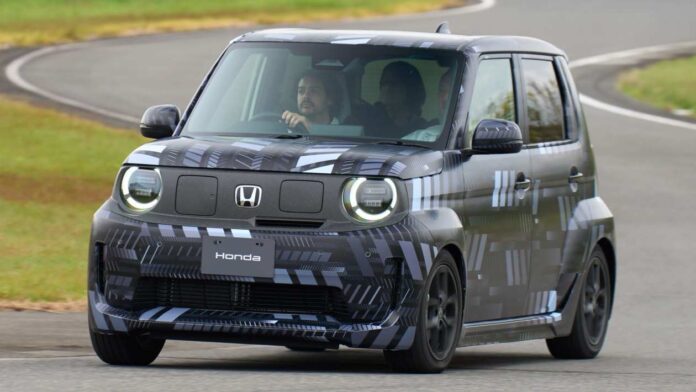Honda is poised to introduce a charming and compact electric vehicle, the Super-N, aiming for international appeal. While not the most technologically advanced EV, the Super-N distinguishes itself with a unique appeal, particularly highlighted by its clever “Boost” mode. The car is slated for release in the UK next summer, and promises a fresh take on the electric microcar market.
The Quest for Fun: Honda’s Approach to Electric Driving
Honda’s latest endeavor seeks to inject joy into the electric car experience – a joy defined not by raw power, but by a sense of unpretentious fun. This concept underpinned the design of the Super-N, and initial testing suggests Honda might be on to something special.
Kei Cars: A Foundation of Simplicity and Efficiency
The Super-N’s origins lie in Honda’s One series of kei cars, popular in Japan. Kei cars are characterized by their compact dimensions and engine size, designed as a cost-effective alternative to standard passenger cars. They excel in navigating Japan’s urban landscapes and remain surprisingly popular even outside major cities. This legacy of efficiency and practicality forms the bedrock of the Super-N’s design.
The Super-N: An Evolution of the Honda N-One e
The Super-N builds upon Honda’s existing all-electric N-One e. While appearing relatively new, this prototype reveals a deeper connection to Honda’s kei car lineage. The core hardware, including a 29.3kWh battery pack and front-mounted electric motor, remains consistent. Due to the compact nature of kei car design, there’s surprisingly ample space for batteries, filling the gap previously occupied by a traditional fuel tank.
Key Specifications and Performance Enhancements
- Battery & Motor: 29.3kWh battery, single electric motor (front-axle drive)
- Range: Approximately 183 miles (Japanese model)
- Charging: Up to 50kW DC charging
- Power & Torque: Enhanced beyond the standard N-One e’s 63bhp and 115Nm (exact figures pending)
Boost Mode: Simulating a Traditional Driving Experience
A significant development is the “Boost” mode. This feature introduces virtual gears and engine noise, mimicking the feel and sound of a traditional internal combustion engine (ICE) car. Inspired by systems found in cars like the Hyundai Ioniq 5 N, it leverages speakers and motor performance mapping to simulate gear changes and engine sounds. Three visual dials on the driver’s display further contribute to the experience.
Design Tweaks for Global Appeal
To broaden its appeal beyond the kei car market, Honda has modified the Super-N’s design. This includes widening the wheelarches and updating the nose and tail for a more aggressive aesthetic. The car rolls on 15-inch wheels, and the suspension has been completely reworked, with development work conducted in the UK. The UK’s challenging road conditions even prompted engineers to increase the volume of the artificial engine noise.
A Simple Interior with a Focus on Support
The interior maintains a simple and understated design, reflecting the car’s accessible nature. While sharing elements with the N-One, the Super-N introduces new seats with enhanced bolsters for improved lateral support during cornering. Practicality is solid, with a decent number of storage cubbies and unusual van-like cup holders.
Driving Impressions: A Light and Nimble Microcar
Despite its upright stance, the Super-N’s seating position doesn’t place the driver too high, and the somewhat oversized steering wheel inspires confidence. Activating the Boost mode unleashes the car’s true character, with a surprisingly deep and resonant growl emanating from the speakers. In default gear mode, the car shifts through gears like a traditional automatic.
Manual Mode and Performance
The left-hand paddle engages manual mode, transforming the gearbox into a responsive system reminiscent of a Golf 7 DSG. A simulated rev limiter prevents over-revving, mirroring a feature found in the Hyundai Ioniq 5 N. While further enhancements, such as customizable performance maps and synthesized pops and bangs, are planned for future models, the current iteration provides a captivating driving experience.
Balancing Performance and Handling
The Super-N demonstrates surprisingly high grip levels and feels remarkably light, with an estimated kerbweight of 1,350kg. Though the steering lacks a little feedback, this is likely a deliberate choice for ease of use.
Pricing and Competition: Targeting an Accessible Market
Honda aims to position the Super-N at a competitive price point, potentially significantly undercutting rivals like the MINI Cooper E. Whispers suggest a starting price in the low-£20,000 range, putting it into competition with the BYD Dolphin Surf. However, future competition from the Renault Twingo and Volkswagen ID.1, slated for release in 2026 and 2027, will challenge Honda’s market position. These emerging rivals are anticipated to offer greater range and potentially more competitive pricing.
Conclusion: A Promising Step for Honda’s Electric Future
Despite the anticipated competition, the initial drive of the Honda Super-N is incredibly promising. It’s uncommon to be genuinely charmed by a modern electric vehicle, and the prospect of a summer 2026 launch is undeniably exciting. This quirky and engaging microcar may just redefine the electric city car segment, proving that small cars can be both efficient and full of personality.
Model:Honda Super-N
Base price:£20,000-22,000 (est)
Powertrain:29.3kWh battery, 1x e-motor
Transmission:One-speed automatic, front-wheel drive
Power/torque:63bhp/119Nm (TBC)
0-62mph:8.3 seconds (TBC)
Top speed:78mph (TBC)
Range/charging:183 miles/90kW (15-80% in -mins) (TBC)
Length/width/height:3,450mm/1,500mm/1,630mm (TBC)
On sale:Q2 2026
